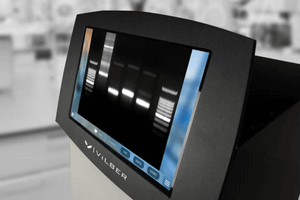A gel documentation system (GDS) captures images of nucleic acids and proteins in agarose or polyacrylamide gels, providing a digital footprint that is indispensable for qualitative and quantitative analysis. Integrating these systems into laboratory workflows has significantly increased the throughput and reliability of experimental data. This article delves into the mechanics, applications, and advancements in gel documentation, highlighting its critical role in modern scientific research.
Mechanism and Components
A typical gel documentation system comprises an imaging enclosure, a high-resolution camera, a light source (UV or blue light), and image analysis software. The camera captures images of the gel, which are then analyzed using the software. The software component is integral, offering features such as lane identification, molecular weight calculation, and quantification of band intensity. The system’s design minimizes external light interference, ensuring the accuracy of the captured images.
Applications in Research
Gel documentation systems find extensive application in various research domains:
- DNA/RNA Analysis: In genomics, GDS analyses PCR products, restriction fragment length polymorphisms, and RNA integrity.
- Protein Analysis: In proteomics, these systems facilitate studying protein expression, molecular weight estimation, and protein-protein interactions.
- Diagnostic Applications: They are pivotal in diagnostic procedures like genetic fingerprinting and disease marker identification.
- Drug Discovery: GDS is crucial in assessing drug targets and biomarkers.
Technological Advancements
Recent advancements in gel documentation technology have focused on enhancing image quality, user-friendliness, and data analysis capabilities. Innovations include:
- High-Resolution Imaging: Improved camera technology enables capturing high-resolution images, allowing for more detailed analysis.
- Automated Analysis: Advanced software algorithms provide automated band detection and quantification, reducing human error and time consumption.
- Integration with Laboratory Information Systems (LIS): Seamless integration with LIS and electronic lab notebooks facilitates better data management and traceability.
Challenges and Future Directions
While transformative, integrating gel documentation systems in modern laboratory research encounters certain challenges. One significant hurdle is ensuring consistent image quality across various experiments and conditions. The precision of gel documentation largely depends on the quality of the image captured. Factors such as gel thickness, staining consistency, and lighting conditions can vary, leading to inconsistencies in image quality. This variability necessitates ongoing refinement in imaging technology and standardization protocols to maintain data reliability.
Another challenge lies in integrating these systems with the rapidly evolving landscape of laboratory technologies. As research methodologies and lab equipment advance, gel documentation systems must be adaptable and compatible with new technologies. This integration is essential for streamlined workflows and efficient data processing, necessitating continuous updates and upgrades to gel documentation systems’ hardware and software components.
Looking to the future, one promising direction is the implementation of artificial intelligence (AI) in gel documentation. AI-driven analysis can offer more sophisticated image interpretation, potentially automating complex tasks such as pattern recognition and anomaly detection. This could lead to faster, more accurate data analysis, reducing the cognitive load on researchers and minimizing human error.
Another future development could be adopting cloud-based data management for gel documentation systems. Cloud storage and computing could enhance data accessibility, collaboration, and security. This approach would allow researchers to access and share data remotely, facilitating collaborative research efforts across different locations. Additionally, cloud-based systems could offer more robust data backup and recovery options, ensuring data integrity.
Lastly, the development of higher throughput systems is an essential future direction. As research demands grow, there is a need for gel documentation systems capable of handling larger sample sizes and providing faster processing times. Such advancements would significantly increase lab efficiency, allowing researchers to conduct more experiments in less time, thus accelerating scientific discovery.
These challenges and future directions underscore the dynamic nature of gel documentation systems in laboratory research. Continuous innovation and adaptation are key to ensuring these systems remain at the forefront of scientific exploration and discovery.
How Scintica’s Gel Documentation Systems are Advancing Scientific Research
At Scintica, we recognize the transformative role that gel documentation systems play in modern laboratory research. Our commitment is to provide the scientific and preclinical research community with the most advanced and reliable instrumentation, ensuring our clients can conduct their research with the utmost precision and efficiency. Our gel documentation systems are designed to meet and exceed evolving scientific inquiry needs.
With top-notch imaging quality, sophisticated software for precise analysis, and seamless integration with various lab technologies, our solutions are tailored to empower researchers. We understand the challenges in the field and are dedicated to simplifying the process for scientists, enabling them to achieve their research objectives and advance their work swiftly. We are committed to fostering scientific progress and discovery by offering focused support and cutting-edge tools.
